
Should I Wrap My Couch in Plastic for Storage? Pros, Cons & Best Practices
Learn when plastic wrap helps or harms couch storage, compare protective options, and follow a step‑by‑step guide to keep your sofa safe for months.
Plastic wrap furniture might sound like a gimmick, but it’s actually a practical answer to three big problems in schools: cost, durability, and flexibility. The material is lightweight, easy to clean, and can be reshaped or moved without heavy lifting. That means teachers spend less time worrying about broken chairs and more time focusing on lessons.
Because the frames are covered in a thin, protective film, scratches and spills slide right off. You don’t need a special cleaner – a damp cloth does the job. Parents appreciate the low‑maintenance aspect, and school budgets love the lower price tag compared to traditional wood or metal pieces.
First, the cost savings are real. A full classroom set of plastic wrap desks and chairs can be up to 30% cheaper than standard models. That extra money can go toward books, tech, or extra staff. Second, the furniture is built to handle the rough‑and‑tumble environment of a busy classroom. The wrap protects the underlying structure from dents, so the pieces stay usable for years.
Third, flexibility is built in. Since the units are light, you can rearrange them for group work, exam settings, or special projects in seconds. No need to call maintenance to move heavy tables. The modular design also lets schools add or subtract pieces as classrooms grow or shrink.
Finally, the material is recyclable. When a school decides it’s time for an upgrade, the wrap can be stripped off and the base frame recycled, reducing waste. That fits well with green initiatives many schools now promote.
Start by listing the activities your room hosts most often. If you do a lot of collaborative projects, look for desks with built‑in power outlets and a flat surface that can hold laptops. For art classes, choose chairs with rounded edges and a sturdy base to withstand heavy supplies.
Check the weight rating. Most plastic wrap chairs hold up to 120 kg, which covers most students, but some high‑traffic areas may need a higher limit. Also, test the wheel lock on any mobile desk – a secure lock prevents accidents when the unit is pushed against a wall.
When you compare suppliers, ask for a sample. A quick hands‑on test will show you how the wrap feels under a hand and whether the frame feels solid. Look for a warranty that covers both the wrap and the frame for at least three years; that signals confidence in durability.
Lastly, think about aesthetics. The wrap comes in many colours – bright primary shades for younger grades or muted tones for secondary schools. Picking a colour that matches your school’s branding can make the room feel cohesive without extra décor.
Plastic wrap furniture isn’t a fad; it’s a smart, cost‑effective way to equip classrooms with pieces that last, adapt, and stay looking good. By focusing on budget, durability, and flexibility, schools can create learning spaces that support both teachers and students without breaking the bank.

Learn when plastic wrap helps or harms couch storage, compare protective options, and follow a step‑by‑step guide to keep your sofa safe for months.